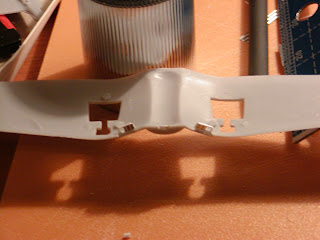Over at the Replica in Scale blog a few weeks back, I stumbled upon a treasure trove of images of post World War II Corsairs. In the entry "The Last of the Deltas, Studies in Glossy Sea Blue, The Infrequent Model, Mystery Meat,and A Salute to the Cat", there is a section titled "Can You Hear Your Bluebird Sing?". There, you'll find an image of a Goodyear FG-1D Corsair in Navy Reserve markings at NAS Grosse Ile, Michigan, sometime in the late 1940's or early 1950's.
There is nothing special about the plane, except for the fact that its markings are not quite standard. Clearly, the Corsair had seen better days, but it was inspiring in spite of its plainness.
I decided to model this Corsair as an experiment of sorts using the classic Hawk/Testor's kit. First off, I decided to use an old favorite color of mine, Testor's Flat Dark Sea Blue, number 1172. When I was a teenager, I frequently used this color on US Navy aircraft of that period. Many purists twinge at the thought of using a color that is not quite a match, but in this case, it was justified; it looks slightly faded, as the Corsair does in that photo.
The next part of the experiment was to see how much detail could be eked out of the model using the barest minimum. In this case, that would translate into opening up the wing inlets, adding a little detail to the wheel wells and landing gear, and opening up the cockpit and adding a simple seat.
I chose to tackle the wings first. Opening up the wing inlets was a simple task accomplished with a file and X-Acto knife. Detail was cobbled together from scrap plasticard and an unusual corrugated Mylar ribbon I picked up nearly twenty years ago, and which still appears at some craft stores from time to time.
I used the same ribbon material to detail the wheel well interior.
Opening up the cockpit was a relatively simple task, made easy with knife and file as well.
One thing I did notice about this kit. There were a number of minor short shots in the molding, as can be seen in the above image. These were easily taken care of with putty. One short shot, however, was a bit problematic if I had not planned on modifying the model's landing gear; the rear struts were short shot, something I did not discover until I began work on them. These were due to be cut and moved up the gear, however, so they really weren't a problem.
The rest of the construction was fairly straightforward. The classic Testor's 1172 Dark Sea Blue, mixed with a few drops of linseed oil, was used over the entire aircraft, brush painted. The interior color is Testor's Zinc Chromate, a bit more yellowish but pretty close. A seat was made from scrap plasticard with harnesses made from drafting tape. The propeller was also slightly modified in shape, closer to the prototype's, and painted (note; the author had managed to break the prop's shaft, and had to resort to creative repair. In the end, it was salvaged and spins just fine). Once satisfied, the blades were painted flat black, with a silver and red hub.
I tried to stick strictly to the kit's decals, however had to use a full set of national insignia for the fuselage due to the international orange band. The "I" on the tail and starboard wing top were made from the arrow decals found in the kit, as well as a spare set from another Testor's kit. The "51"'s were created from the "157" decals, again using a spare from the other kit for the wing. The final decal modification was adding the red bars to the insignia; this was done by painting scrap decal material flat red and cutting out the lengths needed. They had a somewhat ragged appearance, but anyone who works with color in the field will tell you, red fades very quickly. Once the decals had set, some mild weathering was done using Testor's Silver paint, and the entire model sprayed with Dullcote.
The landing gear were detailed with new rear struts cut from florist's wire, while the kit struts were cut and moved up closer to the wing.
Finally, two antenna were added from the plasticard stock and painted to match. Also, the cowling was rotated so that not only did the cylinders match the drawings better, the top three flaps were sanded and filled, as there aren't any there on -1 Corsairs and blending that section of the cowling into the fuselage. This was actually done after the vast majority of the painting. The final touch was some modest weathering along the propeller blade leading edge.
With that, the model was declared finished.
It makes an interesting companion piece to another Testor's Corsair built more or less straight from the kit.
For the price, the classic Testor's Corsair has plenty of potential, not only for the beginner but us seasoned builders as well.
Edit - One thing I did fail to mention is how the canopy was handled. While a proper -1D series Corsair had a hood that was frameless, I used the kit's canopy as is, simply not painting those frames. Admittedly, this was the lazy way out, but then again in 1977, replacement canopies were unheard of and I always had problems making my own. A minor problem, yes, but one which still exists, and which I openly acknowledge.










